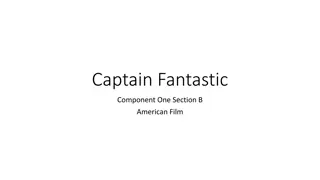Comparative Study of Noir Elements in Blade Runner and Classic Films
Explore the neo-noir style in Blade Runner compared to classic film noirs of the 1940s and 1950s. Understand the dark, bleak, and shadowy set designs, psychological explorations, and societal themes that characterize these films. Compare Blade Runner with iconic films like Double Indemnity and Sin City to analyze genre announcements and common elements. Delve into the use of light, shadow, violence, and urban realism in approaching noir films, with practical examples from Blade Runner.
Download Presentation

Please find below an Image/Link to download the presentation.
The content on the website is provided AS IS for your information and personal use only. It may not be sold, licensed, or shared on other websites without obtaining consent from the author. Download presentation by click this link. If you encounter any issues during the download, it is possible that the publisher has removed the file from their server.
E N D
Presentation Transcript
FM 2 Section C: US Film Comparative Study Blade Runner
Blade Runner as Neo Noir Film noir was a term initially used by French critics (literally dark or black film ) to describe Hollywood films of the 1940s and early 1950s characterized by cynicism and pessimism and set within an oppressive urban world of crime and corruption. The heroes are usually disillusioned men who face an uncertain future alone, friendship is difficult and only possible at a certain distance, love is most usually perverted in some way, and innocence cannot survive in such a world. The boundaries between good and evil become uncertain within a murky underworld experience typified by blackmail, bribery, murder and continual deception.
Stylistic Features of Noir In style the films are dark, stark and bleak, with sets dominated by shadows of various depths that seem continually to threaten the main protagonist, and frames that often contain black or fog-bound or smoky spaces that threaten to engulf not only the characters but the film itself and the society it presents for our attention (as a classic example see the ending to The Big Combo (Lewis, 1955) with the blinking, uncertain light offering only a faint possibility of hope for the future). Although the key examples usually referenced are gangster/crime films, the style is also found in other genres such as melodramas and westerns. (Work such as that of the director Carol Reed and cinematographer Robert Kraskerin Britain on Odd Man Out (1947) and The Third Man (1949) also, incidentally, shows that this style, and thematic outlook on the world, was not confined to Hollywood.)
Film Noir Comparison ACTIVITY Watch the opening to Sin City (Miller/Rodriguez/Tarantino, 2005), and the trailer for Double Indemnity Make notes on the ways in which these films announce their genre to us. Discuss any similarities you notice with reference to Vertigo or Blade Runner. As always do try to discuss your ideas with others, if possible.
Approaching Noir Films For films in the classic noir or neo-noir mode it is always worth considering: the psychological exploration of the darker side of humankind that takes place the social exploration of the darker side of society that takes place the urban realism that often sees modern life as a labyrinthine hell the use of light and shadow as representations of good and evil/danger the use of sparse sets that could be seen to represent the bleak psychological world in some way the use of psychological and actual violence, often within relationships and particularly within the sexual dimension of male female relationships. ACTIVITY- come up with an example of how each of the above are used in Blade Runner
The Opening ACTIVITY Watch the opening sequence built around the credits, noting as many images and sounds as possible. Record your impressions, making sure to try to decide what this opening makes you think the film will be about, justifying your ideas by reference to the images and sounds encountered. If possible, discuss your ideas with a group of others. To what extent did you agree with each other s assessments?
Visual Images-Aesthetics Dark shadows seem to dominate Blade Runner and at certain points Ridley Scott makes it deliberately difficult for the viewer to see the action within the frame. Can you identify any moments in the opening sequences which seem to use film noir lighting, settings and iconography? Does this contribute to the mood of the film? Look closely at the sequence where we are first introduced to Deckard. How from the way he is positioned within the frame is his sense of alienation conveyed? Sum up the film viewer s first impression of him. How much does Deckard conform to the central male film noir character who is usually a disillusioned loner, a tough guy at odds with himself?
Film Noir & SciFi Iconography The tale of grizzled bounty hunter Rick Deckard and his mission to execute a mutinous gang of replicants synthetic biological androids who are barely distinguishable from humans Ridley Scott s third film remains his most beloved and richly layered work. But does it still hold up decades later? And what can Blade Runner tell us about technology, politics, architecture, life, death and the human condition in 2015?
Character and Film Noir Look closely at the sequence where we are first introduced to Deckard. How from the way he is positioned within the frame is his sense of alienation conveyed? Sum up the film viewer s first impression of him. How much does Deckard conform to the central male film noir character who is usually a disillusioned loner, a tough guy at odds with himself? The hero of film noir films is inevitably fatally attracted to a woman who manipulates and betrays him. This woman is referred to as the femme fatale ; she is always very physically attractive with tight-fitting clothes, jewellery and a way of smoking cigarettes which draws attention to her body. She is usually mysterious and controls the hero with her changes of mood. She is dangerous and will lead him to his doom. These women are strong and active and can be seen as positivie portrayals of women but they are also threatening and disruptive. Look at the sequence where Deckard first meets Rachel at the Tyrell Corporation. How do her clothes, hair and make up mimic the 1940 s film noir femme fatale ? After watching the film can you identify how Rachel s character and behaviour does not seem in keeping with the femme fatale image.
Deckard and Roy In what ways are they different? What would you say are their primary characteristics? What messages and values do they represent? Do you feel more sympathy for one than t other? Which one and why? Comment in particular on their relationship with others.
Gender in Blade Runner What does the film suggest about attitudes to gender and/or ethnicity? Comment on the male characters-positive or negative representations? Link to Film Noir and/or SciFi if appropriate. Comment on the female characters-how are they represented? Comment on the relationship between Deckard and Rachel, with particular reference to the rape scene. In an interview Ridley Scott claimed it was a cinematic necessity that the main female character, the replicantRachael, should look so fresh and beautiful, because that is what patriarchal technology would do in creating a female robot or replicant.
Sample Examination Question Compare how gender is represented in one sequence from each of your chosen films. Refer to one character from each film. COMPARE- you will be comparing this film with Vertigo . GENDER- Rachel as representative of women-how is she presented in this sequence? Comment on her behaviour, her appearance, her interaction with Deckard, her qualities, her function within the scene.
The Role of Women in Blade Runner The female roles, all happen to be artificial (replicants) and are sexualized by the men around them. This gives whole new meaning to the term "objectifying women" since they are manufactured. Pris is a "basic pleasure model". Zhorabecomes an erotic dancer performing with a snake. Rachael is supposed to be a copy ofTyrell's niece (with implanted memories). Her ambiguous part-secretary, part femme-fatale character can be read as being objectified one of the questions in herVoight-Kampff test seems to question her sexuality. "Is this testing whether I'm a replicant or lesbian Mr. Deckard?" Depending on one's view of replicants, she then becomes Deckard's "love interest" or "love object". Tyrell's niece is an unseen character.
The role of women The film-noir setting provides further context of the portrayal of women in film, with the femme-fatale historically portraying women as dangerous, uncaring, devious, sexualized and deadly as a reaction to changing roles after World War II.J.F. Sebastian is lured by Pris' sexuality, a naked Zhora catches Deckard off-guard, and then there is the forbidden love with Rachael. Critics may believe Blade Runner misogynist, given that Pris and Zhora can be seen as "strong, independent and non-subservient women" who are killed, whereas Rachael who is the opposite lives. This point, however, must be seen in light of the dystopian setting, in which strong, independent characters of either gender are typically systematically removed.
Sex and Race in Blade Runner http://www.bfi.org.uk/news-opinion/news-bfi/features/blade-runner iWth hindsight, the sexual and racial politics of Blade Runner certainly belong more to the late 1970s than today. Besides a few marginal background characters, all the women are replicantsemployed in male fantasy roles: Pris the basic pleasure model sex worker, Zhora(Joanna Cassidy) the scantily dressed exotic dancer, and Rachael (Sean Young) the icy femme fatale who swiftly surrenders to Deckard s bullying advances. The single sex scene between Deckard and Rachael is uncomfortably one-sided, at least at first. A longer shot of their embrace, now available as an out-take, is more tender and erotic but still not wholly consensual. Scott admits this scene is one of the least successful in the movie . Both Ford and Young have expressed unease about it.
Themes in Blade Runner Identity and Memory
Recommended Activities https://bladerunner.fandom.com/wiki/Themes_in_Blade_Runner https://jessicadavidson.co.uk/2019/02/04/blade-runner-part-1- memory-and-identity/
Politics and Blade Runner Beneath the noir trappings, though, Blade Runner is about slavery and injustice. The replicants face exploitation and discrimination. They re more sympathetic than Deckard, who murders them one by one. Roy Batty (Rutger Hauer) kissing Pris (Daryl Hannah) after Deckard kills her is one of the film s iconic scenes, suggesting that Roy is a more reflective, loving, and sensitive soul than the film s protagonist.
Closing Sequence What messages and vales are explored within the final sequence- Deckard on the roof with Roy? How are both characters represented in this sequence?
Comparing Double Indemnity with Blade Runner We will be considering: The similarities between the films in relation to genre- aspects of film noir The differences- neo noir- the evolution of genre The representation of men and women The way that setting is explored- urban Messages and values within each Context- how does the time in which they were made impact on the films- social, historical, etc The notion of archetypes within film























